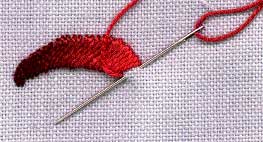Satin stitch
A variety of straight stitch


![]()
Satin stitch is also known as damask stitch.
As one of the oldest embroidery stitches to be found satin stitch is worked on traditional embroideries in practically every country. The traditional embroiderers of China and Japan excelled in the use of this stitch. It is formed by working straight stitches close together.
To use satin stitch to advantage stitches should lie evenly and closely together and some practice is needed to gain this effect. Stretch the fabric in an embroidery hoop or frame to prevent puckering. This stitch is only suitable for small areas as long satin stitches can become loose and untidy. If you need to cover a larger area divide the shape into more workable areas. The other alternative is to use long and short stitch or encroaching satin stitch.
To work the stitch bring the thread up through the fabric and make a single straight stitch. Bring the needle out very close to the stitch just made and continue to fill the shape.
Stitches related to single satin or straight stitch in this dictionary are Satin stitch and Padded satin stitch.
